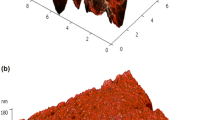Abstract
In thе work, changes in the surface electrical resistance of p-Si crystals were investigated under the simultaneous action of the magnetic field and elastic uniaxial deformation. It was established that a sharp decrease (leap) of resistance occurs at the moment of transition from compression to unclamping at a magnitude of a mechanical load exceeding 18 MPa. Such a leap of resistance is not observed under the elastic uniaxial deformations, which do not exceed 14 MPa. This can be explained by the fact that due to the deeper and more prolonged penetration of the dislocation loops, and the corresponding increase in their length, they accumulate a significant number of charged defects that remain unplaced at the beginning of the release (reduction of the field of mechanical stress). A fluctuation of the resistance value in the direction of increase or towards the reduction occurs in the magnetic field. The diffusion of magnetically sensitive defects into the near-surface region can be explained by the repetition of the processes described in time. In a deformed crystalline lattice, diffusion processes occur more rapidly, which increases the frequency of oscillations of the resistance value. By investigating the IR absorption spectra of experimental samples, it was shown that the decay of defects on the surface (111) of p-Si crystals occurs during a long-term action (288 h) of a constant magnetic field (B = 0.354 T). Such defects are hydrogen-containing and oxygen-containing complexes (Si–O–Si, Si–Si, Si–H2, Si–C, O–Si–O, Si–O–C, Si–CH3, H–OH, H2O, Si–OH). This leads to an increase in the surface resistance of the experimental samples of silicon.





Similar content being viewed by others
Abbreviations
- IR:
-
Infrared
- R(σ):
-
The dependence of the electric resistance on the magnitude of the elastic mechanical deformation
References
Fedosov AV, Luniov SV, Fedosov SA (2011) Influence of uniaxial deformation on the filling of the level associated with A-center in n-Si crystals. Ukr J Phys 56(1):69–73
Golovin Yu I (2004) Magnetoplastic effects in solids. Phys Solid State 46(5):789–824. https://doi.org/10.1134/1.1744954
Koplak O, Morgunov R, Buchachenko A (2013) Magnetic isotope and magnetic field effects on the silicone oxidation. Chem Phys Lett 560:29–31. https://doi.org/10.1016/j.cplett.2013.01.003
Koplak OV, Dmitriev AI, Morgunov RB (2014) Kinetics of oxidation of subsurface layers of 29Si-enriched silicon in a magnetic field. Phys Solid State 56(7):1443–1448. https://doi.org/10.1134/S106378341407021X
Lys RM, Pavlyk BV, Didyk RI, Shykorjak JA (2017) Change in surface conductivity of elastically deformed p-Si crystals irradiated by X-rays. Nanoscale Res Lett 12(440):1–7. https://doi.org/10.1186/s11671-017-2210-x
Lys R, Pavlyk B, Didyk R et al (2018) Effect of elastic deformation and the magnetic field on the electrical conductivity of p-Si crystals. Appl Nanosci 8(4):885–890. https://doi.org/10.1007/s13204-018-0707-y
Makara VA, Steblenko LP, Kolchenko YuL et al (2005) Magnetic-field-induced modification of properties of silicon lattice defects. Solid State Phenom 108–109:339–344
Makara VA, Vasiliev MO, Steblenko LP et al (2009) Influence of magnetic treatment on the microhardness and surface layers structure of silicon crystals. Phys Chem Solid State 10(1):193–198
Molotsky MI (1993) Negative magnetoplastic effect in non-magnetic crystals. Phys Solid State 35(1):11–14
Monastyrskyj L, Aksimentyeva O, Olenych I, Yarytska L (2009) Transmission infrared spectra of low dimension hybrid composites on a porous silicon base. Visnyk Lviv Univ Ser Phys 44:271–276
Morgunov RB (2004) Spin micromechanics in the physics of plasticity. Adv Phys Sci 74(2):131–153. https://doi.org/10.3367/UFNr.0174.200402c.0131
Nadtochiy VO (2006) Extended abstract of Cand. Sci. Dissertation, Khark. National Univ., Kharkiv
Orlov AM, Skvortsov AA, Solov’ev AA (2003) Behavior of dislocations in silicon in the presence of mechanical and magnetic perturbations. J Exp Theor Phys 123(3):590–598
Pavlyk BV, Steblenko LP, Koplak OV et al (2009) Effect of magnetic field on electrophysical parameters of Bi–Si–Al surface-barrier structures. Metallofizika i noveishii tekhnologii 31(9):1169–1178
Pavlyk BV, Hrypa AS, Slobodzyan DP, Lys RM, Shykoryak JA, Didyk RI (2011) The effect of a magnetic field on electrical properties of surface-barrier Bi–Si–Al structures. Semiconductors 45(5):608–611
Pavlyk BV, Lys RM, Didyk RI, Shykoryak JA (2015) Features of the uniaxial elastic deformation of X-ray-irradiated p-Si crystals. Semiconductors 49(5):638–643
Pavlyk B, Kushlyk M, Slobodzyan D, Lys R (2017) Restructing of the defected structure and centers of dislocation luminescence in the p-Si surface layers. J Phys Stud 21(1/2):1601 (1–8)
Skvortsov AA, Karizin AV, Volkova LV, Koryachko MV (2015) Effect of constant magnetic field on dislocation anharmonicity in silicon. Phys Solid State 57(5):914–918. https://doi.org/10.1134/S1063783415050273
Yang X, Zhao X, Bai Y et al (2017) Two-demensional magnetic field sensor based on silicon magnetic sensitive transistors with differential structure. Micromachines 8(4):95. https://doi.org/10.3390/mi8040095
Funding
The study was carried out at Department of Sensor and Semiconductor Electronics, Ivan Franko Lviv National University without additional funding.
Author information
Authors and Affiliations
Contributions
All authors (RL, BP, RD, JSh, MK, DS, IK) developed the methodology and algorithms of experimental studies. RL and RD developed an experimental facility for the investigation of mechanically induced changes of electro conductivity of p-Si crystals. All authors read and approved the final manuscript.
Corresponding author
Ethics declarations
Conflict of interest
The authors declare that they have no competing interests.
Additional information
Publisher’s Note
Springer Nature remains neutral with regard to jurisdictional claims in published maps and institutional affiliations.
Rights and permissions
About this article
Cite this article
Lys, R., Pavlyk, B., Didyk, R. et al. Features of changes in the electrical resistance of p-Si crystals under the action of an elastic one-axial mechanical load and a magnetic field. Appl Nanosci 9, 1775–1779 (2019). https://doi.org/10.1007/s13204-019-00964-z
Received:
Accepted:
Published:
Issue Date:
DOI: https://doi.org/10.1007/s13204-019-00964-z



